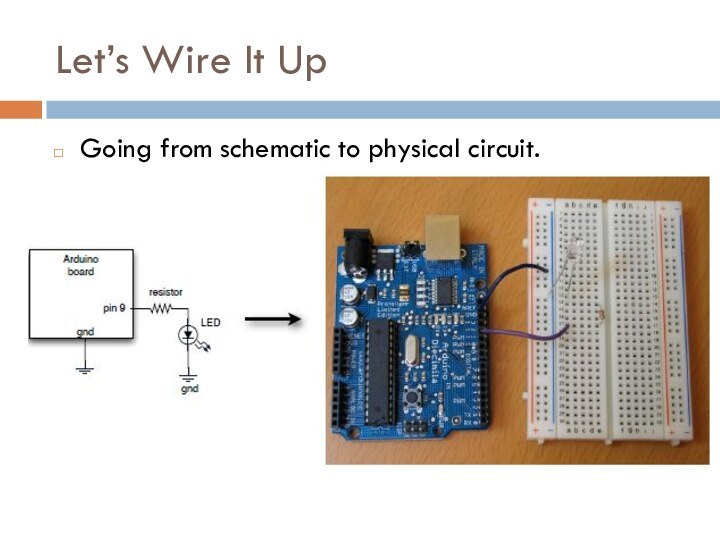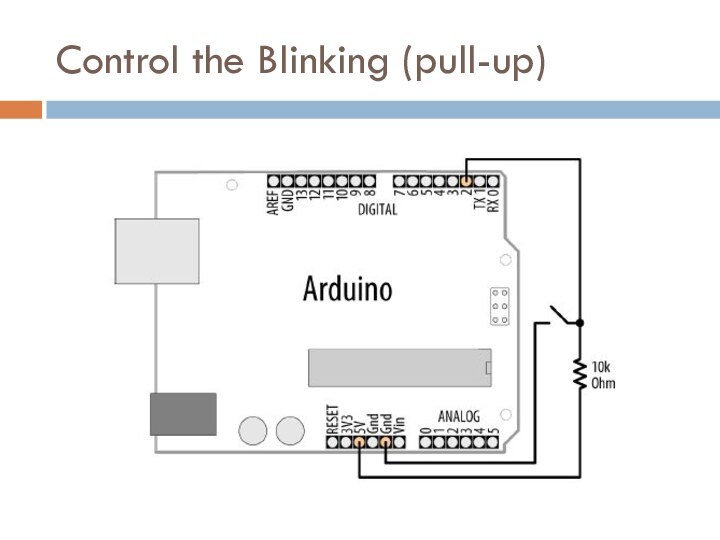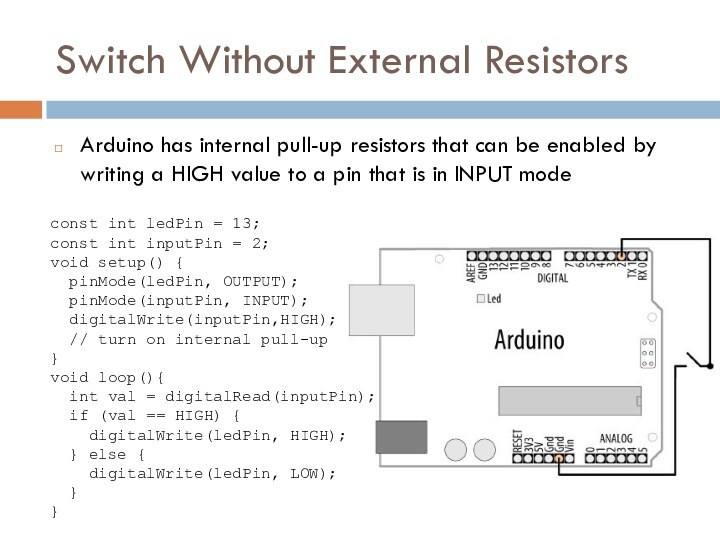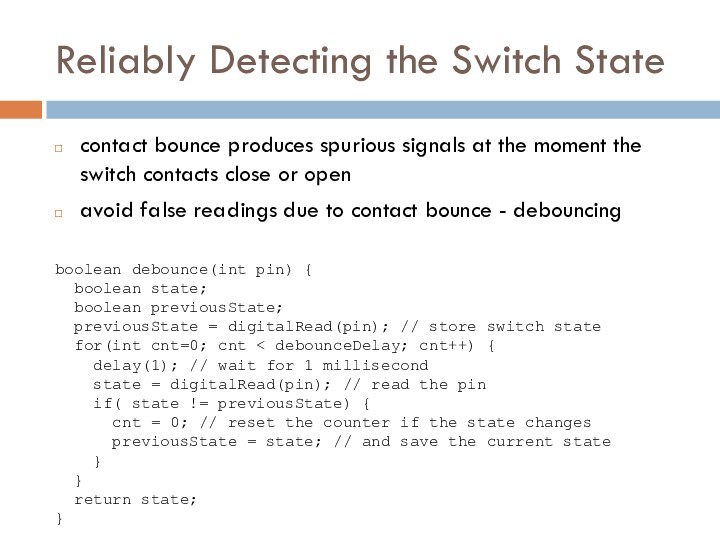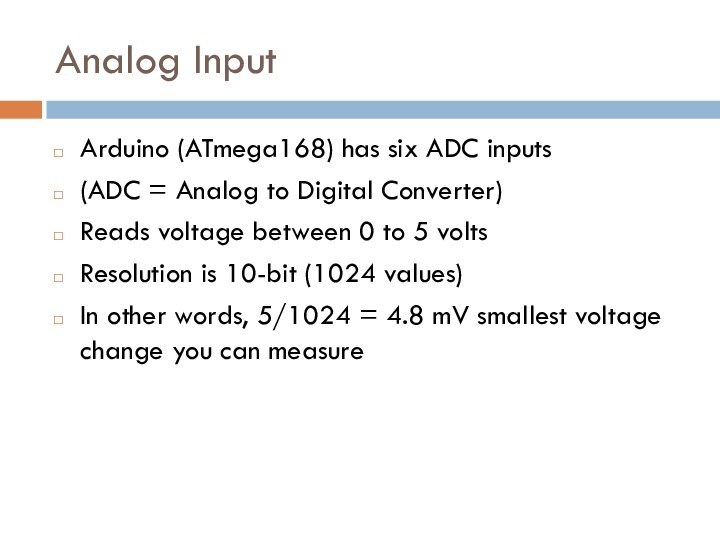Слайд 2
Simple Digital and Analog Inputs
The Arduino’s ability to
sense digital and analog inputs allows it to respond
to you and to the world around you
Digital input pins sense the presence and absence of voltage on a pin
Analog input pins measure a range of voltages on a pin
Слайд 3
Simple Digital and Analog Inputs
digitalRead(pin) - tells your
sketch if a voltage on a pin is HIGH
(5 volts) or LOW (0 volts)
pinMode(pin, INPUT) – configure pin as an INPUT
14 digital pins (numbered 0 to 13)
Pins 0 and 1 (marked RX and TX) are used for the USB serial connection
Need more?
Analog pins 0 through 5 can be used as digital pins 14 through 19
Слайд 4
Simple Digital and Analog Inputs
Still need more?
Analog pins
0 through 15 are digital pin numbers 54 through
69
Слайд 5
Sensors & Inputs
Many sensors are variations on switches
Switches
make or break a connection
Single pole = only one
circuit is being controlled
Double pole = two circuits are being controlled at once
Single throw = only one path for circuit
Double throw = two potential paths for circuit
Слайд 6
Many Kinds of Switches
Tilt sensor has a little
ball inside
Magnetic switches are delicate
The hex switch is actually
many switches in one, and outputs 4 signals
Слайд 7
Digital Input
Switches make or break a connection
But Arduino
wants to see a voltage
Specifically, a “HIGH” (5 volts)
or a “LOW” (0 volts)
How do you go from make/break to HIGH/LOW?
Слайд 8
From Switch to HIGH / LOW
With no connection,
digital inputs “float” between 0 & 5 volts (LOW
& HIGH)
Resistor “pulls” input to ground (0 volts)
Pressing switch “pushes” input to 5 volts
Press is HIGH
Not pressed is LOW
Pull-down resistor
Слайд 9
Pull-up and Pull-down
pull-up resistors – pull the voltage
up to the 5V line that the resistor is
connected to
pull-down resistors – pull the voltage down to 0 volts
Although 10K ohms is a commonly used value, anything between 4.7K and 20K or more will work
Слайд 10
Control the Blinking
Connect a button to pin 2
with a pull-down resistor
Turn on LED if button pressed
and OFF if released
Слайд 11
Control the Blinking
// Pushbutton sketch a switch connected
to pin 2 lights the LED on pin 13
const
int ledPin = 13; // choose the pin for the LED
const int inputPin = 2; // choose the input pin (for a pushbutton)
void setup() {
pinMode(ledPin, OUTPUT); // declare LED as output
pinMode(inputPin, INPUT); // declare pushbutton as input
}
void loop(){
int val = digitalRead(inputPin); // read input value
If (val == HIGH) { // check if the input is HIGH
digitalWrite(ledPin, HIGH); // turn LED on if switch is pressed
} else {
digitalWrite(ledPin, LOW); // turn LED off
}
}
Слайд 12
Let’s Wire It Up
Going from schematic to physical
circuit.
Слайд 16
Using Solderless Breadboards
Using needle nose pliers can help
push wires & components into holes
Слайд 18
Using Switches to Make Decisions
Often you’ll want to
choose between actions, based on a data obtained from
switch-like sensor
E.g. “If motion is detected, turn on the lights”
E.g. “If flower pot soil is dry, turn on sprinklers”
Define actions, choose them from sensor inputs
Let’s try that with the actions we currently know
E.g.: If button is pressed send “Hello!” to serial port, and if released send “Goodbye!”
Слайд 20
Switch Without External Resistors
Arduino has internal pull-up resistors
that can be enabled by writing a HIGH value
to a pin that is in INPUT mode
const int ledPin = 13;
const int inputPin = 2;
void setup() {
pinMode(ledPin, OUTPUT);
pinMode(inputPin, INPUT);
digitalWrite(inputPin,HIGH);
// turn on internal pull-up
}
void loop(){
int val = digitalRead(inputPin);
if (val == HIGH) {
digitalWrite(ledPin, HIGH);
} else {
digitalWrite(ledPin, LOW);
}
}
Слайд 21
Reliably Detecting the Switch State
contact bounce produces spurious
signals at the moment the switch contacts close or
open
avoid false readings due to contact bounce - debouncing
boolean debounce(int pin) {
boolean state;
boolean previousState;
previousState = digitalRead(pin); // store switch state
for(int cnt=0; cnt < debounceDelay; cnt++) {
delay(1); // wait for 1 millisecond
state = digitalRead(pin); // read the pin
if( state != previousState) {
cnt = 0; // reset the counter if the state changes
previousState = state; // and save the current state
}
}
return state;
}
Слайд 22
Analog Input
To computers, analog is chunky
Слайд 23
Analog Input
Many states, not just two (HIGH/LOW)
Number of
states (or values, or “bins”) is resolution
Common computer resolutions:
8-bit
= 256 values
16-bit = 65,536 values
32-bit = 4,294,967,296 values
Слайд 24
Analog Input
Arduino (ATmega168) has six ADC inputs
(ADC =
Analog to Digital Converter)
Reads voltage between 0 to 5
volts
Resolution is 10-bit (1024 values)
In other words, 5/1024 = 4.8 mV smallest voltage change you can measure
Слайд 25
Analog Input
Sure sure, but how to make a
varying voltage?
With a potentiometer. (pot)
Слайд 26
Potentiometers
Moving the knob is like moving where the
arrow taps the voltage on the resistor
When a resistor
goes across a voltage difference, like +5V to Gnd, the voltage measured at any point along a resistor’s length is proportional to the distance from one side.
Слайд 27
What good are pots at?
Anytime you need a
ranged input
Measure rotational position
steering wheel, robotic joint, etc.
But more
importantly for us, potentiometers are a good example of a resistive sensor
Слайд 28
Arduino Analog Input
Plug pot directly into breadboard
Two “legs”
plug into +5V & Gnd (red + & blue
-) buses
Middle “post” plugs into a row (row 7 here)
Run a wire from that row to Analog In 2











